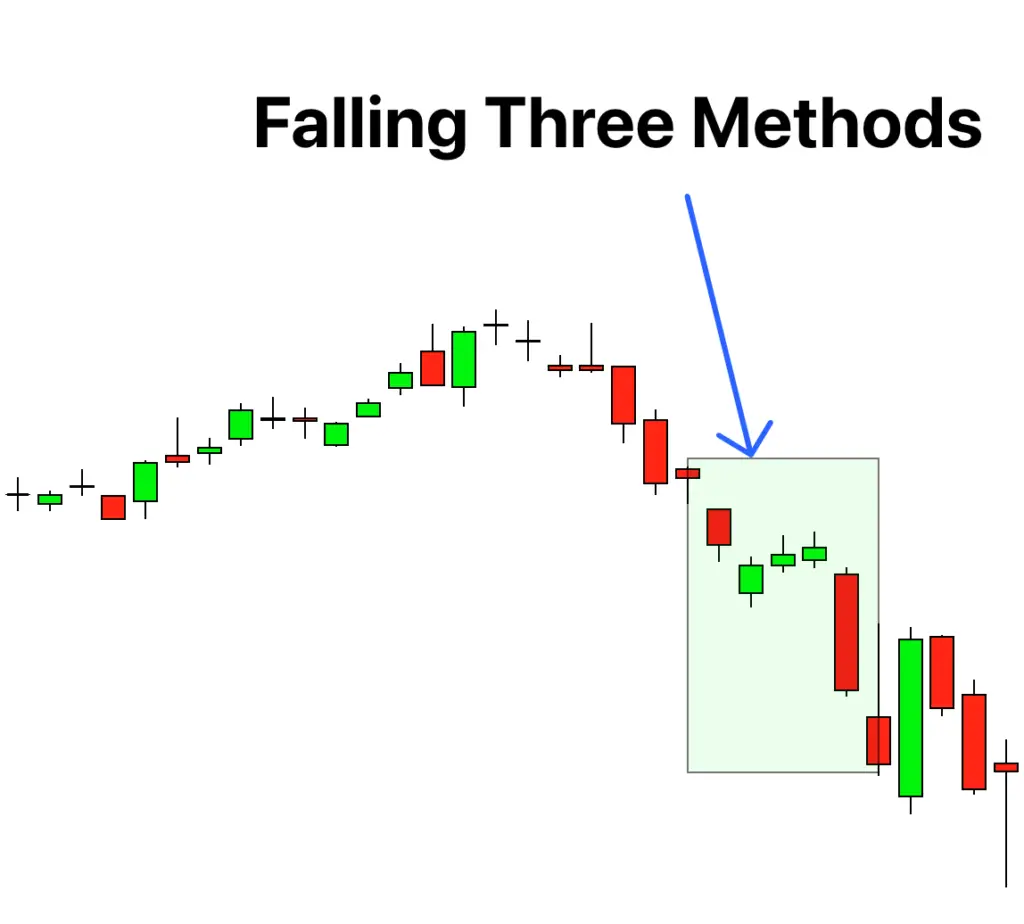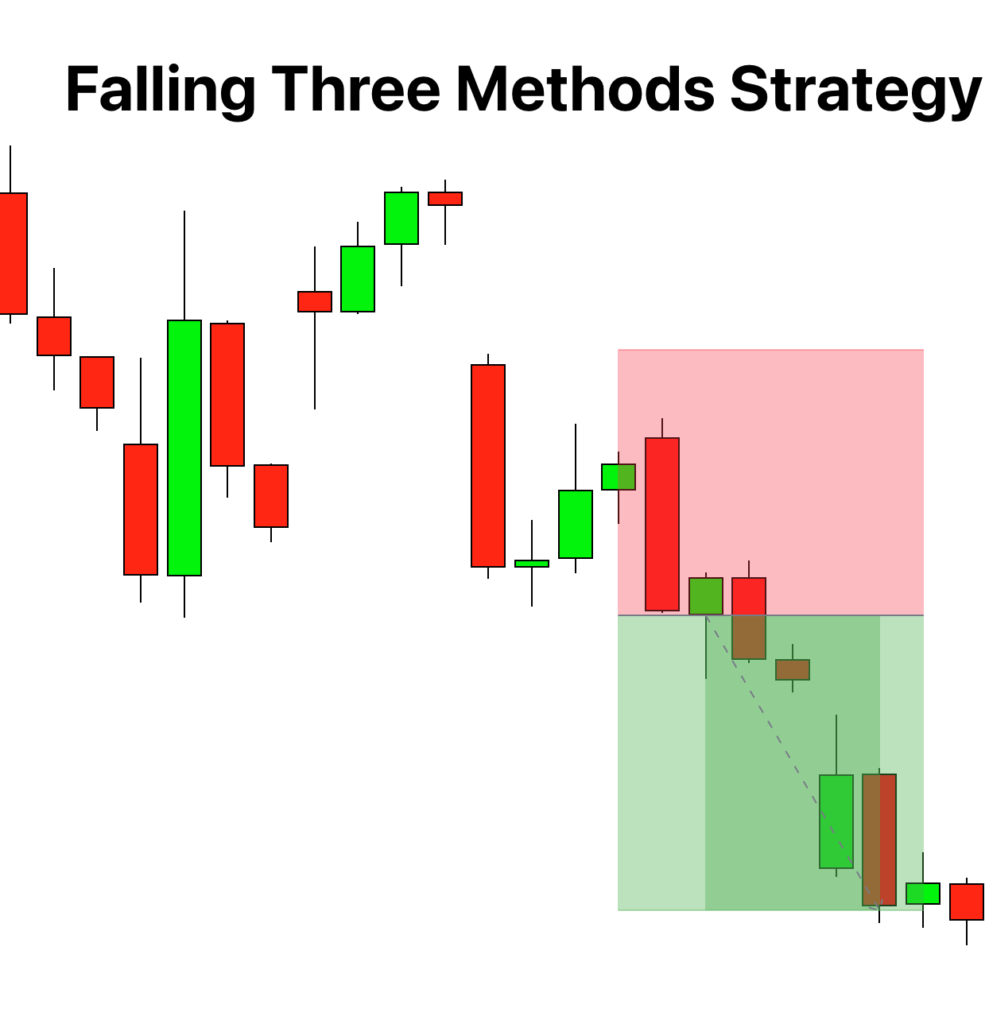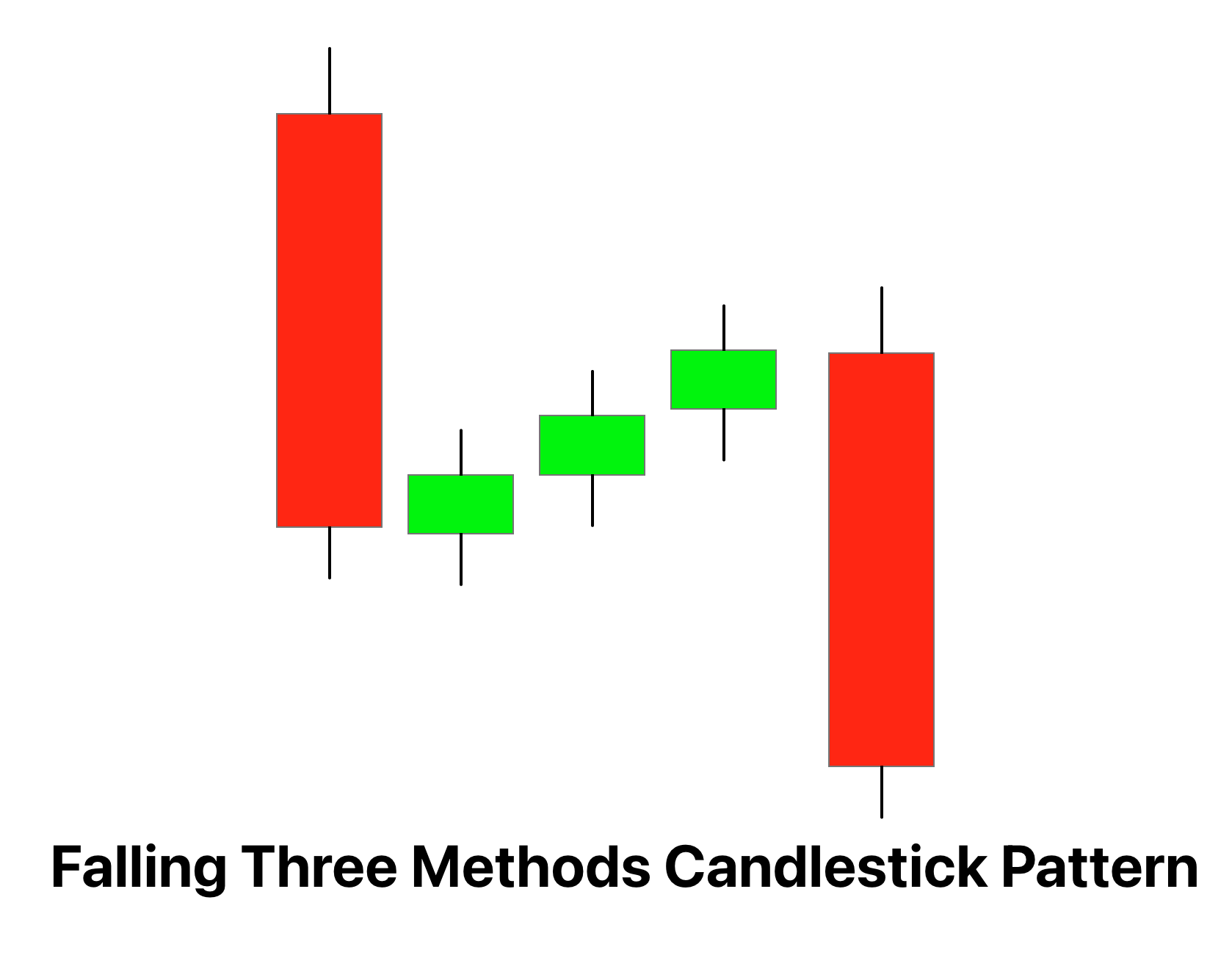Definition
The Falling Three Methods is a bearish continuation candlestick pattern, comprising of five candles, that signals an existing downtrend is likely to continue.
The Falling Three Methods pattern is a unique candlestick configuration that provides traders with valuable insights about the continuation of a bearish market trend, assisting them to make informed trading decisions.
How to identify the falling three methods candlestick pattern?
To correctly identify the Falling Three Methods pattern on a trading chart, traders should look for the following characteristics:
- Prevailing Downtrend: The pattern forms during a prevailing downtrend. It is essential as it signifies the continuation of the downtrend.
- Long Black Candle: The first candle in the pattern is a long black (or red) candle, which continues the current downtrend.
- Three Small Candles: Following the first black candle are three small candles, preferably white (or green), that remain within the range of the first candle. These represent a brief period of consolidation or minor price retracement, but they don’t reverse the downward trend.
- Final Black Candle: The fifth candle is another long black (or red) one that closes at a new low, engulfing the three small candles. This indicates a resumption of the original downward trend.
Significance
The Falling Three Methods candlestick pattern is a bearish continuation pattern, signaling that the current downtrend is likely to continue. Its significance and indications can be understood as follows:
Confirmation of Downtrend: The pattern is an affirmation of a prevailing downtrend. Its formation during a downward price movement validates the continuation of bearish market sentiment, suggesting that sellers are still in control and that the price could descend further.
Consolidation Period: The three small candles within the pattern indicate a brief period of consolidation or slight bullish resistance. However, the fact that they fail to push the price up significantly suggests the limited strength of buyers in the market, again hinting at a probable continuation of the downtrend.
Resumption of Bearish Activity: The final long black (or red) candle, which closes at a new low, signifies the resumption of strong bearish activity after the brief pause. This suggests that the selling pressure is dominant and that the market participants anticipate further price decline.
Potential Entry Point: For traders, the completion of the Falling Three Methods pattern can act as a potential entry point for short selling or for exiting long positions. The continuation of the downtrend could present an opportunity for profits from further decreases in price.
Activity of traders behind the chart
The activity of big traders or institutional investors is pivotal in the formation of the Falling Three Methods candlestick pattern.
Initiation of the Pattern: The pattern begins with a strong bearish candle. This usually suggests a significant sell-off by big traders, initiating a solid downward move.
Consolidation Phase: The subsequent smaller candles indicate a brief period of consolidation. In this phase, institutional investors may be offloading further positions or simply taking a pause, allowing retail investors or short-term traders to enter the market and cause a minor upward price movement. This doesn’t necessarily indicate a change in trend, but more of a breather in the prevailing downtrend.
Continuation of Downtrend: The final bearish candle, which exceeds the low of the first candle, signifies the return of the big players. This is where institutional sellers resume their activity, overpowering the buying pressure and confirming the continuation of the bearish trend.
For retail traders, understanding this institutional activity is beneficial as it can guide their market decisions. They can follow the ‘footprints’ of these big traders and use the pattern as a signal to either short sell or exit long positions, aligning their trades with the predominant market sentiment and direction.

Confirmation of falling three methods pattern
Here are the few confirmation tools that helps to find the high probability candlestick pattern.
| Confirmation Tools | Description |
|---|---|
| Key Level | The pattern should form near a key resistance level for greater reliability. This indicates that the market has tested this level and is likely to continue its downward trend. |
| Break of Low After Pattern Formation | A significant break below the low of the pattern, particularly the low of the first and the last candle, provides a solid confirmation. This suggests that the sellers are in control and the price is likely to continue moving down. |
| High Volume | Increased volume on the bearish candles of the pattern, especially the first and the last one, adds to the validity. This suggests strong selling pressure, reinforcing the continuation of the downtrend. |
| Bearish Trend Confirmation | Use trend confirmation tools like moving averages. If the pattern forms under a major moving average line (like the 50, 100, or 200-period), it can indicate a bearish trend continuation. |
Key Points to remember
Best Timeframe: The Falling Three Methods pattern tends to be most reliable on daily and weekly charts. These higher timeframes help filter out the market noise, providing a clearer view of the market trend.
Trading Session: For this pattern, it is usually more effective during the London and New York sessions as these are the most active trading periods with greater volume, especially when trading major currency pairs.
Winning Ratio: An approximate winning ratio for the Falling Three Methods pattern can be around 65-70%. This ratio assumes that the pattern is traded in the context of a trending market with suitable confirmation tools.
Trading Strategy with Falling Three Methods Candlestick Pattern
- Identify the Pattern & Confluence: First, identify the Falling Three Methods pattern in a downtrend. Ideally, this pattern should form near a confluence zone – such as a previously identified resistance level, Fibonacci retracement level, or a downward trend line.
- Entry Point: The entry point should be as soon as the final bearish candle (the fifth candle) closes, confirming the pattern. This indicates that sellers have regained control, and the price is likely to continue falling.
- Stop-Loss: The stop-loss order should be placed slightly above the high of the pattern. This placement provides room for the price to fluctuate without prematurely stopping out the trade. If the price moves above the high of the pattern, it invalidates the pattern and indicates a possible trend reversal.
- Take-Profit: As for the take-profit level, traders can use a risk-reward ratio, such as 1:2 or 1:3, depending on their trading style and risk tolerance. Alternatively, the target can be set at a lower support level or a significant Fibonacci extension level.

Conclusion
The Falling Three Methods is a bearish continuation pattern that signifies a pause in market selling pressure in a downtrend, followed by a resumption of selling. Its identification can be complex due to the pattern’s specific five-candle structure, but when properly recognized and confirmed by volume and other technical tools, it can provide valuable insight for traders.


